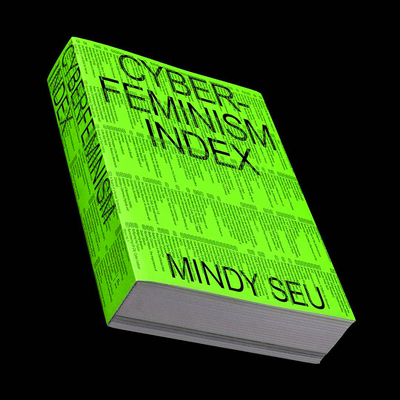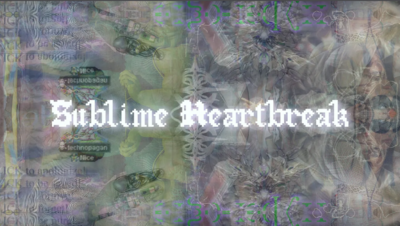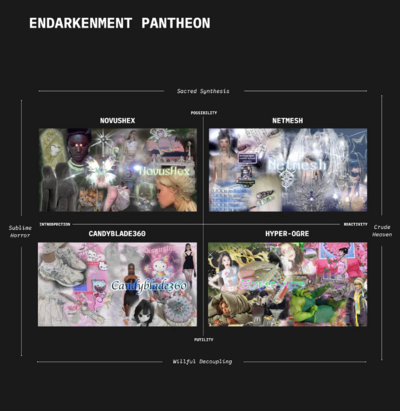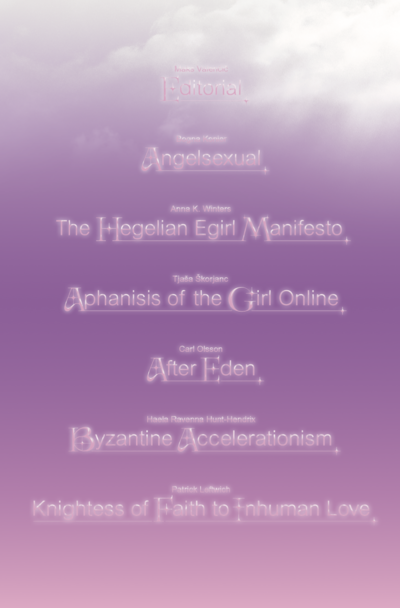[002]
Cyberfeminism Index
Individual
critical

Cyberfeminism Index by Mindy Seu
In Cyberfeminism Index, hackers, scholars, artists, and activists of all regions, races and sexual orientations consider how humans might reconstruct themselves by way of technology. When learning about internet history, we are taught to focus on engineering, the military-industrial complex, and the grandfathers who created the architecture and protocol, but the internet is not only a network of cables, servers, and computers. It is an environment that shapes and is shaped by its inhabitants and their use.
The creation and use of the Cyberfeminism Index is a social and political act. It takes the name cyberfeminism as an umbrella, complicates it, and pushes it into plain sight. Edited by designer, professor, and researcher Mindy Seu, it includes more than 700 short entries of radical techno-critical activism in a variety of media, including excerpts from academic articles and scholarly texts; descriptions of hackerspaces, digital rights activist groups, and bio-hacktivism; and depictions of feminist net art and new media art.
Both a vital introduction for laypeople and a robust resource guide for educators, Cyberfeminism Index—an anti-canon, of sorts—celebrates the multiplicity of practices that fall under this imperfect categorization and makes visible cyberfeminism’s long-ignored origins and its expansive legacy.
“the Cyberfeminism Index is incomplete and always in progress..”
15.12.25
[003]
The Cell for Digital Discomfort (CfDD)
Collective
critical
Formed as part of the 2021/2022 BAK Fellowship for Situated Practice, the Cell for Digital Discomfort (CfDD)—composed of Cristina Cochior, Karl Moubarak, and Jara Rocha—are the guest editors of this special Prospections focus “Digital Discomfort,” a compilation of newly commissioned and archival resources such as texts, interviews, and videos that allow for a collective exploration of sensibilities around an affirmative repoliticization and redefinition of compu-relational practice.
15.12.25
[009]
Glitch Poetics
Individual
critical
Glitches are errors where the digital bursts or creeps into our everyday lives as fragmented image, garbled text and aberrant event. Today, when computational technology is integrated ever more closely into bodies and social structures, glitches are considered by artists and companies alike as critical and commercial opportunities, revealing tears in the real-virtual binary. Glitch has also increasingly become a metaphor for understanding the political and ecological shocks the world pushes into the mediasphere each day. In Glitch Poetics Nathan Jones shows how contemporary writers and artists are integrating the glitch as a literary effect, an affective critique and a realist reflection, at a time characterised by breakage, corruption and crisis.
Based on a range of close readings of contemporary literature by writers including Linda Stupart, Sam Riviere, Keston Sutherland, Ben Lerner, Caroline Bergvall, Erica Scourti, David Peace and the internet novelists, and drawing on theories of error, shock, glitch, critical posthumanism and code, Jones lays the groundwork for writing that can productively engage in the new situation for literature in the context of AI, the Anthropocene and the post-digital age. His book articulates the working of error in literary and media practice at the horizon of human and machine language.
“Glitch Poetics resists technofuturism, reinventing errancy as a necessary aesthetic value of (and crucially against) our time.”
15.12.25
[010]
Vertical Atlas
Collaboration
social
How to navigate the rapidly changing digital geopolitics of the world today? How do we make sense of digital transformation and its many social, political, cultural, and environmental implications at different locations around the world?
Vertical Atlas brings together the insights of a diverse group of internationally renowned artists, scientists and technologists from different backgrounds and places. From an investigation into the lithium mines in the Democratic Republic of Congo to maps of the fiber-optic submarine cables in the Atlantic and the ride-hailing platforms of China.
Vertical Atlas is not a classic atlas that depicts the world in a uniform manner and it is not a simple collection of traditional maps. This book is a tool that enables comparisons, connections and contradictions between different and diverse visions, realities and worlds – through newly commissioned diagrams, interviews, essays and works of art by leading experts from around the world.
15.12.25
[013]
A Traversal Network of Feminist Servers
Collective
social
A Traversal Network of Feminist Servers is a collaborative project formed around intersectional, feminist, ecological servers whose communities travel between each other to share and extend their skills through live gatherings. Such platforms and tools are necessary to navigate our communications and cultural growth beyond the current media oligopolies and democratize cultural and political expression outside obscure algorithms and advertising monetization. The project is documented through a mobile server and a print publication, each chapter being shaped by a partner.
15.12.25
[015]
Interdependence FM
Collaboration
speculative
In an age where global events, technologies, and cultures are increasingly intertwined, the Interdependence FM podcast explores the intricate web of connections shaping our world. While the hosts talk to artists and experts in the field of AI (and beyond) and are mainly positive about the 21st century, it becomes clear that understanding the concept of interdependence has never been more crucial.
15.12.25
[018]
Figuring Things out Together
Individual
critical
This dissertation explores matters of collectivity, drawing from the experience of working with the Amsterdam-based collective Hackers & Designers (H&D). The main thesis of this research is that conventional design vocabularies are not capable of sufficiently expressing and accounting for collectivities‘ resistance to fixation and stabilization. Collective design as it is discussed here challenges notions of individual authorship, differentiations between disciplines, between product and process or between the user and maker. While collectives shape particular affiliations and commitments, design approaches and aesthetics, they also require perspectives on working and designing together that resist linearity, and a progress-based understanding of a design process. By means of several case studies, it is argued that the fragmentation of social and work relations is as much a characteristic of collective practice as the effort to sustain long-term relationships.Thus, collective practice is not fully deliberate, at least not in the same way as for instance ‘teamwork’, ‘the commons’, or ‘cooperativism’, are purposeful organizational frameworks for living, working or being together. Collective Collective design processes take part in and are a result of particular (often fragile) socio-economic, socio-technical conditions that pervade and shape the ways collectives function.
“This publication derives from an enthusiasm for the various ways collective learning environments take shape. It grew out of a curiosity for the ways that such practices are shared across different localities, timelines, and experiences.”
15.12.25
[022]
Pirate Care, a syllabus
Collective
critical
Pirate Care is a research process - primarily based in the transnational European space - that maps the increasingly present forms of activism at the intersection of “care” and “piracy”, which in new and interesting ways are trying to intervene in one of the most important challenges of our time, that is, the ‘crisis of care’ in all its multiple and interconnected dimensions.
These practices are experimenting with self-organisation, alternative approaches to social reproduction and the commoning of tools, technologies and knowledges. Often they act disobediently in expressed non-compliance with laws, regulations and executive orders that ciriminalise the duty of care by imposing exclusions along the lines of class, gender, race or territory. They are not shying risk of persecution in providing unconditional solidarity to those who are the most exploited, discriminated against and condemned to the status of disposable populations.
The Pirate Care Syllabus presents here for the first time is a tool for supporting and activating collective processes of learning from these practices.
“We live in a world where captains get arrested for saving people’s lives on the sea; where a person downloading scientific articles faces 35 years in jail; where people risk charges for bringing contraceptives to those who otherwise couldn’t get them. Folks are getting in trouble for giving food to the poor, medicine to the sick, water to the thirsty, shelter to the homeless. And yet our heroines care and disobey. They are pirates.”
15.12.25
[030]
Our Digital Selves
Collaboration
speculative

‘Ecstatic Wholeness’ by The Fabricant

‘Ecstatic Wholeness’ by The Fabricant
"With the emergence of the Metaverse, we can reinvent ourselves in ways in which we’ve always dreamt. Modem teamed up with The Fabricant, SHOWstudio and Anastasiia Fedorova to imagine how our virtual alter-egos could change the ways we think about ourselves. Expanding on the work of The Fabricant, which explores the malleable future of human identity through non-physical garments, Our Digital Selves studies the ambiguous relationship between the real and the virtual self"
“When musing on fashion and identity, it’s always worth asking: when does wearing something truly change the meaning of who we are?”
15.12.25
[031]
A Website is a Room
Individual
autonomous
A-website-is-a-room.net is a little handmade web space that features a live feed of urls of a similar sentiment, anonymously contributed by fellow internet travelers. This site is the distillation of extensive research, conversations, and experiments around alternative web practices, decentralized networks, and online gathering.
The goal was to make something communal, romantic, introspective, raw, and beautiful. I also really wanted to dive deep into the research, and in that process, discovered a whole world of like-minded people, learned about new and old tools, and drew unexpected connections between different artists, designers, and their works.
15.12.25
[034]
Seduced & Abandoned: The Body in the Virtual World - The Feminine Cyberspace
Individual
critical
Sadie Plant argues that cyberspace is a potentially radical space which uses modes of thinking and operating that have traditionally been seen as female. She also considers the relationship between cyberspace and immaterial space and speculates on what this could mean for the future. Christine Tamblyn and Pat Cadigan contribute to the discussion/Q&A, which makes for a lively discourse on the females positioning in technoculture.
15.12.25
[036]
GIRLSTACK
Individual
speculative

image by siir bicer
Building on the ideas of Tiqqun’s 1999 anti-neoliberal treatise Preliminary Materials for a Theory of the Young-Girl, Andrea Long Chu’s Females and Bogna Konior’s work on the girl and the inhuman vis-a-vis the machinic, Quicho has developed a concept she calls the “Girlstack,” which, to borrow her words, models the “ultrasmooth, cybergothic, and angelic dimensions of the girl’s natural habitat.” Quicho articulates how the ‘girl’ inhabits no one person, body, or gender. She is a technology of subjectivity composed of symbolic, consumer, and inhuman elements and might be our only way out of the platform trap. Quicho's reformulation of 'the stack' was first published as an essay on Wired and expanded at BODYSTACK and Creamcake 3HD.
Quicho’s girl-stack is a speculative prototype models themany dimensions of the girl’s natural online habitat. To be clear: Quicho does not speak of actual girls or the experience of lived girlhood, but a socially constructed ideation of the girl. So, the girl as a vehicle for selling product, the girl as a tool for manipulating entrenched power, the girl as living currency, and the girl as desiring machine. The model is imperative for understanding the environment that produces the ‘girl as condition’.
15.12.25
[037]
Notes on Phygitality
Collaboration
speculative
Published in Issue#6 of NXS Magazine ‘Phygital Fashioning’, ‘Notes on Phygitality’ documents an asynchronous dialogue held in the spring of 2022.
The conversation delves into the concept of "phygitality," blending physical and digital realms. They explore its implications, noting, "It’s about how you can interface between the physical and the digital." Discussions encompass the fusion's impact on human interaction voicing that we have more freedom to express ourselves. Ethical dimensions are scrutinized: "We need to be careful about what that [digital footprint] means." The dialogue reflects on art, privacy concerns, and the intricate interplay shaping future socio-technological landscapes.
15.12.25
[041]
I'm Like a PDF but a Girl
Individual
pedagogy
A literary and ethnographic analysis of the Tumblr platform, supplemented by personal experiences, to explore the site's potency as a pedagogical tool. Ester Freider explains.. "I'm Like a Pdf but a Girl originates from my usage of tumblr as a social learning platform during high school, when AFK I had little educational resources surrounding feminist studies, philosophy, and potential leftisms in my high school and so, turned to a network of peers online to educate myself."
“Embrace subjectivity. Nomadologize. Unclog digital neuroses. Reconnect with the ancients. Atomize. Overflow with information. Make love piratic. Plagiarize with the girls. Weave webs of excess. Become a girlblogger.”
15.12.25
[042]
From a Tool to a Culture : Authorship and Professionalism of Fashion 4.0 Designers in Contemporary Digital Environments
Individual
This thesis looks at how fashion design is affected by new technology. It contributes to fashion studies and design research. It uses ideas from authorship theory, sociology of professions and posthumanism. The research looks at four fashion design practices where creation takes place in virtual spaces and is shared with non-professionals, networks or machines. The case studies are The Fabricant, Atacac, Self-Assembly and Minuju.
15.12.25
[047]
Sublime Heartbreak: Vectors for an Ending of Times
Individual
Speculative

Image by Elizabeth Gabrielle Lee

Endarkenment pantheon and its vectors: Possibility ⟷ Futility, Introspection ⟷ Reactivity. The intersection of these vectors (aka quadrants) give rise to aesthetic guilds. Image by Elizabeth Gabrielle Lee
This essay explores the concept of "Endarkenment," an aesthetic response to current global crises. Instead of apocalyptic destruction, Endarkenment finds beauty in chaos and decay. It contrasts traditional enlightenment, emphasizing engagement with darkness and complexity. Four aesthetic "guilds"—NovusHex, Netmesh, Candyblade360, and Hyper-ogre—illustrate different aspects of this concept, embracing both technological and primitive elements to find new forms of meaning and enchantment amid widespread despair and systemic failures.
The essay's concept of "Endarkenment" connects to how we experience fashion online by highlighting emerging digital aesthetics and trends that embrace chaos, complexity, and non-traditional beauty. Online fashion communities reflect this through styles like "indiesleaze" and "ratgirlsummer," which celebrate raw, unpolished looks, and "technomysticism" that merges spirituality with cybernetics. Platforms like Instagram curate these trends, showcasing designs that fuse nature with technology or embrace hyper-femininity and grotesque, anti-minimalist aesthetics. These digital movements redefine fashion by rejecting conventional norms and finding beauty in unconventional, dark, and chaotic expressions.
“I propose Endarkenment, an aesthetic posturing that’s emerging from the abyss of ultimate system failures and chronic mass despair. I’m not interested in a doomsday, pure-nihilistic dystopian narrative.”
15.12.25
[051]
Towards A Minor Tech (Peer-reviewed newspaper)
Collaboration
critical
Following a process of open exchanges and a three-day research workshop in London, at London South Bank University and King’s College, London, this publication brings together researchers who address the problems of technological scale, thinking through the potentials of 'the minor'; or what we are referring to as minor (or minority) tech – small tech that operates at human scale (more peer to peer than server-client) and stutters in its expression and application. As Marloes de Valk puts it in the Damaged Earth Catalog: “Small technology, smallnet and smolnet are associated with communities using alternative network infrastructures, delinking from the commercial Internet.” As such, the publication sets out to question the universal ideals of technology and its problems of scale, extending it to follow the three main characteristics identified in Deleuze and Guattari's essay (Toward a Minor Literature), namely deterritorialization, political immediacy, and collective value.
“we're exploring how technological scale sets conditions for relations, feelings, democratic processes, and infrastructures.”
15.12.25
[052]
Xenofeminism
Academia
speculative
In an era of accelerating technology and increasing complexity, how should we reimagine the emancipatory potential of feminism? How should gender politics be reconfigured in a world being transformed by automation, globalization and the digital revolution?
These questions are addressed in this bold new book by Helen Hester, a founding member of the ‘Laboria Cuboniks’ collective that developed the acclaimed manifesto ‘Xenofeminism: A Politics for Alienation’. Hester develops a three-part definition of xenofeminism grounded in the ideas of technomaterialism, anti-naturalism, and gender abolitionism. She elaborates these ideas in relation to assistive reproductive technologies and interrogates the relationship between reproduction and futurity, while steering clear of a problematic anti-natalism. Finally, she examines what xenofeminist technologies might look like in practice, using the history of one specific device to argue for a future-oriented gender politics that can facilitate alternative models of reproduction.
15.12.25
[054]
The Balkanization & Babelification of the Internet
Collaboration
social
This essay explores the fragmentation of the internet, likened to the "Balkanization" and "Babelification" of online spaces. As the unified digital world splits into smaller, private communities, distinct languages and cultures emerge, leading to communication breakdowns when different groups interact. This splintering mirrors the biblical Tower of Babel story and poses challenges to shared understanding. The authors argue that deeper human connection, especially through physical touch, is essential to overcoming these divides and fostering genuine communication.
The essay's discussion of the internet's fragmentation can be linked to online fashion cultures, where digital spaces have become increasingly niche and isolated. Just as the internet splinters into distinct communities with their own languages and norms, fashion subcultures online—like streetwear, high fashion, or vintage—develop their own unique styles, terminologies, and identities. This fragmentation can both foster strong in-group connections and create barriers to broader communication and understanding between different fashion communities, mirroring the challenges of "Babelification."
“When we return to the public squares, it is not uncommon to think: what the hell is anyone saying? Imagine explaining what an 'Aesop Soap Guy' or a 'Sandy Liang Girlie' are to someone who isn't involved in that discourse.”
15.12.25
[055]
Welcome to the Swarm
Individual
social
On the internet, we are part of swarms: networks of people, bots, and content, coordinated through algorithmic feedback loops. Swarms spread misinformation, help each other, and represent the public. This is not our grandparents' crowd. Swarms are networks of people and information. They can act together without set rules. This research looks at different swarms, like the response to Hurricane María, to see how they work together. We also need to look at other online groups to understand swarms better. These groups have rules that make them easier to manage.
The concept of "swarms" can be connected to the online fashion landscape by considering how decentralized, collective behaviors emerge in digital spaces. In fashion, swarms can be seen in how trends develop, spread, and evolve without a centralized authority. Social media platforms, influencer culture, and digital communities act as nodes in a network where fashion trends are collectively shaped, shared, and adopted. These swarms enable rapid shifts in consumer preferences, allowing niche styles to become mainstream almost overnight, reflecting the fluid and adaptive nature of digital fashion ecosystems.
“In a swarm, the whole emerges from local interactions, with no central control or singular direction. This phenomenon can be seen in digital spaces where collective behaviors and patterns emerge organically, driven by the actions and decisions of individual participants.”
15.12.25
[057]
The Wretched of the Screen
Individual
politics
In Hito Steyerl’s writing we begin to see how, even if the hopes and desires for coherent collective political projects have been displaced onto images and screens, it is precisely here that we must look frankly at the technology that seals them in. The Wretched of the Screen collects a number of Steyerl’s landmark essays from recent years in which she has steadily developed her very own politics of the image.
Twisting the politics of representation around the representation of politics, these essays uncover a rich trove of information in the formal shifts and aberrant distortions of accelerated capitalism, of the art system as a vast mine of labor extraction and passionate commitment, of occupation and internship, of structural and literal violence, enchantment and fun, of hysterical, uncontrollable flight through the wreckage of postcolonial and modernist discourses and their unanticipated openings.
“Images are no longer passive reflections; they are active agents, manipulated and distorted by the flows of capital and power, reshaping reality in their own fractured, pixelated image.”
15.12.25
[068]
ŠUM#22 Angel Mode
Collaboration
philosophy

ŠUM22: ANGEL MODE Design by Jaka NeonEdited by Maks Valenčič and Tisa Troha

ŠUM22: ANGEL MODE Design by Jaka NeonEdited by Maks Valenčič and Tisa Troha
The journal ŠUM#22 – Angel Mode explores themes in contemporary art, theory, and speculative fiction. Key articles include topics such as online identities, accelerationist philosophy, the concept of "angelic sexuality," and reinterpretations of faith and love in the digital age. Contributors like Bogna Konior and Haela Ravenna Hunt-Hendrix discuss theoretical frameworks connecting cyberculture and philosophy. The issue is edited by Maks Valenčič and Tisa Troha.
The Angel Mode Issue explores the intersection of online aesthetics and identities, focusing on the "angel" as a symbol for transcendent, hyper-feminine personas. This ties into ongoing online discourse of femininity, vulnerability, and performance, often communicated through ethereal-esque aesthetics, cyberpunk references, and soft romanticism style write-ups. The "angel" metaphor also critiques our roles in cybernetic systems, where humans act as conduits for larger external forces. Embracing this mode reflects a shift from individuality toward alignment with overarching digital and 'transcendental' patterns.
“As human agency erodes, faced with singularity and extinction, the figure of “the girl (on the internet)” is on the rise. In the new issue of Šum we explore how this surrender of agency mediates (human) history itself.”
15.12.25
[079]
PoetiCal
Individual
experimental
PoetiCal is an experimental, collaborative publication only accessible through a calendar app.The only way to access this publication is through a calendar app.
The emergence of platforms such as Poetical.day marks a transformative shift in how individuals engage with and share their creative voices through digital media. Enabling collective publishing through this platform (albeit subject to curatorial selection first) is not just about facilitating content creation, but more about fostering community, as the shared human experience of everyday life is highlighted in form and context. The power of such a 'collective publishing platform' lies in the ability to contribute, collaborate and engage with others in small ways.
15.12.25
[080]
Disintegrator
Collaboration
critical
What does it mean to be human in an age where experience and behaviour are mediated and regulated by algorithms? The Disintegrator podcast is a limited series that explores how artificial intelligence affects who we are and how we express ourselves. Roberto Alonso Trillo and Marek Poliks talk to artists, philosophers, scientists and social theorists at the forefront of the human-AI relationship about the intersections of technology and politics, and the modes of performance and reconsumption through which humans traverse and embed themselves in digital space.
15.12.25
[086]
Consensual Hacking
26.07.25
15.12.25
[089]
Becoming the Product: The Critical Internet Researcher as a Virtual Intellectual
Individual
critical
In Becoming the Product Morgane Billuart traces the evolution of critical internet research, examining the work of figures such as Geert Lovink, Joshua Citarella, Alex Quicho and Sophie Public. Exploring how researchers navigate the demands of the attention economy, the book reflects on the tension between critique and commodification as it traces the shifting strategies of critical research under pressure to perform, produce and build a brand. What happens to critique when intellectual labour becomes part of the content economy? What does it mean to think critically and sustainably online?
Through her own practice, Morgane’s inquiry blurs the line between critique and performance. By hosting two podcasts and maintaining a presence across multiple platforms, including Substack, Instagram and YouTube, she doesn’t just study the dynamics of online visibility — she embodies them.
Her tone shifts from theoretical to personal, revealing a methodological agility attuned to platform aesthetics. By tapping into the systems she critiques, Morgane challenges the divide between observer and participant, and between content and critique. Rather than resolving this tension, her work inhabits it, showcasing the messy, strategic entanglement of intellectual labour and platform capitalism. This is a form of research that is experienced and performed as much as it is written: a vulnerable and incisive mode of enquiry that is shaped from within the infrastructures it studies.
15.12.25







